In the Footsteps of Hugo Rosenthal in Grodno, by Ruth Marcus
By Carol Hoffman On October 16, 2015 ·
http://genealogy.org.il/2015/10/16/in-the-footsteps-of-hugo-rosenthal-in-grodno-by-ruth-marcus/
Introduction
In October 16, 1914, less than three months after the beginning of WW1, Hugo Rosenthal, a Jewish German soldier, was taken prisoner by the Russians after a military assault by the Germans near Brwinow in the vicinity of Warsaw. It was only after a year of searching, and only after Grodno had come under German occupation, that his family found out what had happened to Rosenthal.1 His story is told through original letters sent by his family and friends who were desperately trying to find and arrange for his release from Russian captivity and through various replies received from different places in Europe and Russia. These letters are presented by Hugo's granddaughter – Naomi Rosenthal in the book: Searching for Hugo, which I have read with great interest.2
According to the letters, after his capture by the Russians, Hugo was sent to the fortress-town of Grodno, which in October 1914 was in the Russian Empire. He stayed in two hospitals in Grodno until his death on November 9, 1914.
During the last decade I have been researching the history of the Jewish community in Grodno and have visited Grodno several times. Therefore, I was excited to follow what had happened to Hugo Rosenthal there. My seventh visit to Grodno was in October 2014, several months after reading Searching for Hugo. I took that book with me and decided to walk in the footsteps of Hugo, who had stayed in Grodno for less than a month exactly one hundred years ago. This article describes my tour following the sites in Grodno related to Hugo Rosenthal.
100 Years Later: in the Footsteps of Hugo Rosenthal in Grodno
After his capture by the Russians in the vicinity of Warsaw (on October 16, 1914), the Jewish German wounded soldier was sent to Grodno where Pastor Adolf Plamsch officiated.3 Pastor Plamsch, the pastor of the protestant congregation in Grodno, spoke with Rosenthal in Grodno in October 1914.
My first stop was by the building in Grodno where Pastor Plamsch had lived. This building is located at 7 Academichnaya Street (formerly Kirchnaya Street), by the Lutheran Church of St. John in Grodno.
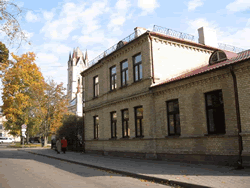
7 Academichnaya Street
The building at 7 Academichnaya Street and the Lutheran Church of St John (behind), 2014
According to a German report dated November 27, 1915 (Searching for Hugo, page 298), Hugo Rosenthal was initially taken to the Red Cross Hospital which was located in the building of the Farmer’s Bank built in 1913 at Sophiskaya Street (now Lenin Street). Dr. Rothenstein, a prominent Jewish doctor in the city, was the head physician of the Red Cross Hospital. He said that Hugo's wounded leg needed no surgery. Against his orders, the wife of the Russian commander of Grodno (their names are not mentioned in the letters) had the patient Rosenthal transferred to the Grodno Military Hospital which was under her authority. She brought him in secret, allegedly so that he would not receive better treatment than the wounded Russian men. His right leg was immediately amputated and a few days later, on November 9, 1914 Hugo died, due to blood poisoning.
My second stop was by the building of the former Red Cross Hospital where Hugo had stayed for a few days. The building is located at 9 Lenin Street. I tried to enter the building. However, the guard standing by the entrance gate of the building didn't allow me to enter since nowadays government and military offices are located inside the building.
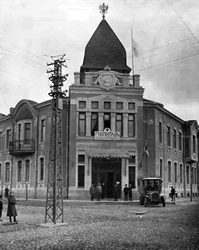
Red Cross Hospital Sophiskaya St. 1915
The Red Cross hospital at Sophiskaya Street, 1915
The building at 9 Lenin Street, 2014
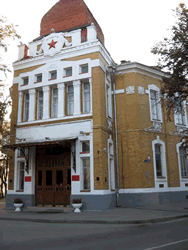
I was standing by the building thinking about Hugo who had been lying in the Red Cross Hospital for a short time exactly one hundred years ago. I was also thinking about Dr. Rothenstein who was trying to help Rosenthal. According to the 1898 Census of the Jewish population of Grodno, Dr. Isaac (born in 1858) son of Israel Rothenstein had been practicing as a doctor since 1882. He lived with his wife and their 5 children at 15 Kolozhanskaya Street (now Kaluchinskaya Street). According to the German report (Searching for Hugo, page 298), after the death of Rosenthal (on November 9, 1914) Dr. Rothenstein resigned his position as head physician and he also died soon afterwards.
I then decided to go to Kaluchinskaya Street, where Dr. Rothenstein and his family had lived. Since the numbers of the buildings had been changed, I was not sure about the exact building where they had lived. Therefore, I just walked along the street, thinking about Dr. Rothenstein and wondering whether he had any living relatives somewhere in the world.4
Kaluchinskaya Street (formerly Kolozhanskaya Street), 2014

Kaluchinskaya Street
I was also thinking about the Russian commander's wife who had secretly moved Rosenthal from the Red Cross Hospital to the Military Hospital. Her name and her husband's name are not mentioned in the letters presented in the book. Based on information (in Russian) received from my colleague in Belarus, the Russian commander of the fortress-town of Grodno in 1914 was General Michael Nikiforovitch Kaygorodov (?????? ??????????? ??????????).5 At that time he was married to Varvara Alekseevna Danilovskaya (??????a ?????????a ???????????). They lived with their three children at 12 Kirchnaya (now 14 Academichnaya) which is close to the Lutheran Church. My next stop was then by the building at 14 Academichnaya Street.
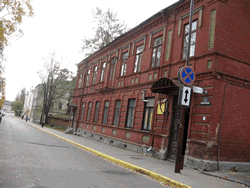
14 Academichnaya Street
The building at 14 Academichnaya Street, 2014
I was standing by the building thinking about the Russian Commander and his wife. According to the Russian source, Varvara Alekseevna was a board member of the Grodno charity society and the chairlady of the board of the Grodno division of the society for rendering help to soldiers and their families who suffered during the war. According to the book "LeDorotai" (Hebrew: "For My Generations") by Hillel Isser Yanovsky, the Russian Commander of Grodno in 1914, Kaygorodov was a nice person who had good relations with the Jews of Grodno. However, his wife was described as a woman of bad character. She was a Russian patriot and wanted to establish a Military Hospital for the wounded Russian soldiers to be called in her name. Yanovsky also mentioned in his memoirs a Jewish physician - Dr. R. (his full name is not mentioned) who became a patriot of the Russian Empire and offered help to the commander's wife in founding and arranging the Military Hospital. Dr. R., who had conflicts with the Jewish Hospital (it is not mentioned what sort of conflicts), told the commander's wife that special expensive surgery instruments were available within the Jewish Hospital. Yanovsky, who at that time was the administrative director of the Jewish Hospital, was shocked when one day the commander's wife came with Dr. R. and two soldiers to the Jewish hospital and confiscated surgery instruments and beds from the Jewish Hospital and moved them to the Military Hospital.6, 7
My next stop was then by the New Castle located at 20 Zamkowa Street. The Military Hospital, which was under the authority of the Russian commander's wife, was located here. Here Rosenthal's right leg was amputated and a few days later, on November 9, 1914 he died due to blood poisoning. After the war, in 1921 Pastor Adolf Plamsch sent a letter to Hugo Rosenthal's wife describing the last days of the life of her husband. He mentioned a German nurse, A. Rasin, who cared for Hugo in his last days. Hugo died in the night of November 9, 1914 and none of the German-speaking nurses were with him. Another soldier who was lying next to him robbed him that night (Searching for Hugo, page 312).
The Military Hospital at the New Castle8, ca. 1915
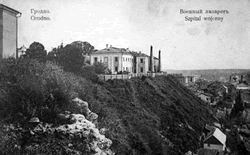
Military Hospital ca 1915
The New Castle, 2014
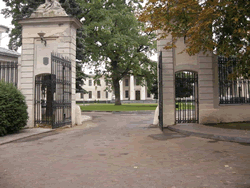
New Castle 2014
The body of Hugo Rosenthal was transferred from the Military Hospital to Hiller Stanetski, the overseer of the Jewish Burial Association of Grodno, for burial according to requirement of the Jewish religion.9 Hugo Rosenthal was buried at the main Jewish cemetery located not far from the center of the city. His family paid for a beautiful tombstone, written in German, Yiddish, and Hebrew.
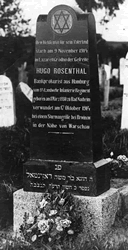
tombstone Hugo Rosenthal
The tombstone of Hugo Rosenthal
The Jewish cemetery was destroyed by the Soviets in 1963 and a sports center and a soccer stadium "Neman" were constructed on that place. I then went to Kammunalnaya Street and walked around the area where the main Jewish cemetery had once been located. In 2007 the Jewish community of Grodno put on the wall of Neman stadium a memorial plaque commemorating the Grodno Jewish community. I was standing by the wall thinking about Hugo Rosenthal - the only Jewish German soldier who was buried here in November 1914, about Dr. Isaac Rothenstein who died shortly afterwards and most likely was buried here, and about my family’s relatives and other Jewish former residents of Grodno whose tombstones had been demolished. With tears in my eyes I read in a loud voice the verse from the "Vision of the Valley Dry Bones" (Ezekiel 36; 5) written on the memorial plaque.
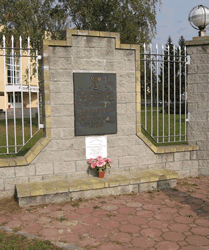
Neman Stadium Memorial Plaque
The memorial plaque on the wall of Neman stadium where the main Jewish cemetery was once located, 2014
Epilogue
The Jewish German soldier – Hugo Rosenthal had stayed in two hospitals in Grodno for less than a month, from sometime between October 17 and 24, 1914, (depending on how many days it took to reach Grodno from where he was captured) until his death on November 9, 1914. I was impressed by the amount of information obtained from the letters regarding his short stay in Grodno. I was excited to read the document (page 301) by Rabbi Abraham Gelbort, the “Moreh Zedek” (Hebrew: teacher of Justice”) in Grodno, attesting to the facts regarding the death and burial of Hugo Rosenthal. There is no recipient address on that document. It is likely that this, as well as other Grodno documents written at that time, were delivered in person to Hugo’s brother-in-law, who had been stationed in Grodno since September 1915, and was in contact with the Grodno Jewish community with regard to Hugo’s death (pp. 282-285 and Naomi Rosenthal, personal communication). 10 I am in contact with two of his g-g-grandsons in Israel who were excited to see this letter. I was also pleased to find a letter sent from the Jewish Vaad Ha'Kehilla (Hebrew: Jewish Community Committee) signed by the secretary A. Schultz (corrected in later printings to A. Schulkes).11, 12 The address of the Vaad Ha'Kehilla on top of the letter was at 4 Ivanover Street, which is now the building at 6 Telmane Street. I then decided to end my tour by the building at 6 Telmane Street. On the way to that building, I stopped by the buildings where my family and other Jewish families whom I had gotten to know during the eight years of my research had lived before the Second World War.

6 Telmane Street
The building at 6 Telmane Street, 2014
While standing by the building in which the Jewish Community Committee had once been located, various thoughts ran through my mind: What a vivid Jewish town Grodno once was… It was known by the Jews as "Ir Giborim" (Hebrew: "A City of Heroes" (book published in 1880) and it was called by Rabbi Arie Leib Halevi Epstein, the author of the book HaPardes: "Ir Klilat Yofi" (Hebrew: "A City Full of Beauty").
Footnotes and References
1. The German conquest of the city of Grodno was on September 3, 1915.
2. Rosenthal Naomi, Searching for Hugo, Publisher: NaoMinRose, 2014.
3. Pastor Adolf Plamsch was born in 1866 in Wenden (now Cesis in Latvia) into a family of Baltic Germans. In 1890 he was ordained as a pastor of the Evangelical Lutheran Church. In 1905 he was appointed as the head of the protestant community in the province of Grodno. After the German conquest of Grodno (in September 1915) Pastor Plamsch was sent to Kazan. He returned to Grodno after 1919 when Grodno was in Poland and served for about 20 more years until his death in February 1939. http://pl.wikipedia.org/wiki/Adolf_Oswald_Plamsch
4. Further interesting information about Dr. I.I. Rothenstein is provided by the author of the book, Naomi Rosenthal (page 319). Naomi and I have been trying to trace family-relatives of Dr. I.I. Rothenstein (1858-1915). Naomi was in contact with a person in the US whose Rothenstein ancestors left Grodno and came to the US. I was in contact with a person in Israel whose Rothenstein ancestors left Grodno before WW2 for then Palestine. At this point we don't know if and how these persons are related to Dr. I.I. Rothenstein.
5. M. N. Kaygorodov was born in 1853 in the city of Polotsk, Vitbesk Gubernia, Russian Empire (now in Belarus). He was a military engineer and Major-General of the Russian army and assumed command of the 26th Infantry Division in Grodno on November 9, 1907. In August 23, 1913 he was appointed to commandant of the fortress city of Grodno. After the German conquest of Grodno he was transferred to the headquarters in Minsk. His exact fate is unknown. According to one report, in 1918 he was shot by the Bolsheviks in Moscow.
6. Hillel Isser Yanovsky was born in 1874 in Grodno. In 1908 he was nominated as the administrative director of the Jewish Hospital in Grodno and served in this position for several years. After WWI, in 1919 he was a member of the Zionist party which participated in the first elections to the "Vaad Ha'Kehillah", the committee of the Jewish Community in Grodno. In 1923 he left Grodno for then Palestine and settled in Rishon LeZion. Between 1936 and 1938 he published the book "LeDorotai" describing his memoirs from the Zionist activity in Grodno and its surroundings. For his memoirs from Grodno in 1914, see: "LeDorotai", Vol.1, pp. 136-140. Hillel Isser Yanovsky died in 1944.
7. Dr. R. is obviously not Dr. Rothenstein who was connected with the Red Cross Hospital and not with the Military Hospital where the commander's wife was. Moreover, Dr. Rothenstein is listed on charities and rights organizations for Jews, which showed his support for the Jewish community, so it is unlikely that he would have taken things from the Jewish Hospital.
8. http://www.radzima.org/be/fota/5489.html
9. A person named Hillel Stanetski is listed on the 1912 voters list of Grodno. It could be that Hiller Stanetski is Hillel Stanetski.
10. Rabbi Abraham Gelbort was born in 1852 in Grodno. He studied at Batei Midrash(Hebrew: Houses of Study) in Grodno and was ordained as a Rabbi by the greatest rabbis of Grodno. At the age of 20 he was recognized as one of the greatest Torah scholars. In 1890 he was appointed "Moreh Zedek" (Hebrew: "Teacher of Justice"), a rabbi who pronounces in disputes and decides in Halachic (Jewish law) questions. He was active and involved in the Jewish community. During WWI, the German military authority accepted his request and gave him permission to establish a temporary Jewish Community Committee for managing the charity and religious needs of the Jews. In 1927 he was appointed as a Head of The Rabbinic Court in Grodno. He died on July 13, 1939. See his letter at: Searching for Hugo, page 301.
11. Aaron Schulkes was born in 1884 in Grodno. Between the two World Wars he was a member of the Zionist organization in Poland. He was elected as the secretary of the "Vaad Ha'Kehillah", the committee of the Jewish Community in Grodno. During WW2, he was murdered by the Germans in 1943. His eldest son and his family survived the Holocaust. After the war they emigrated and settled in Australia.
12. A. Schulkes sent his letter with Plamsch's letter "enclosed" and Plamsch wrote the date of his letter, which is August 22, 1921. See the letter at: Searching for Hugo, page 313.
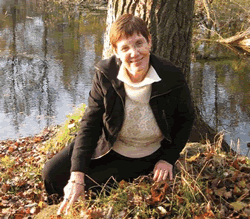
Ruth Marcus
Ruth Marcus was born in Ramat Gan, Israel. She holds a Ph.D. degree in Statistics from the Hebrew University in Jerusalem. Since 1988, Ruth has been involved in researching the roots of her family in Jerusalem, Hungary, Lithuania and Byelorussia. She has published two books (in Hebrew): about her maternal family in Jerusalem, and about the shtetl of Lunna – her father's town of birth. She has also published several articles (in Hebrew, English, Polish and Belarusian) on topics related to her research. She has a Kehilalink site on JewishGen for the town of Lunna: http://kehilalinks.jewishgen.org/lunna. Ruth was also the curator of an exhibition on the "Tarbut" Gymnasium in Grodno, which was opened in October 2012 at the Grodno University, Belarus. |